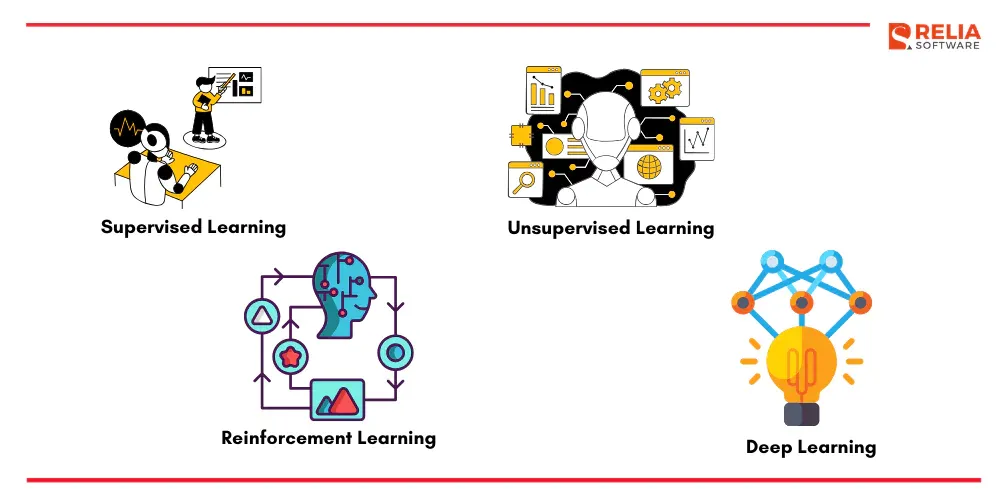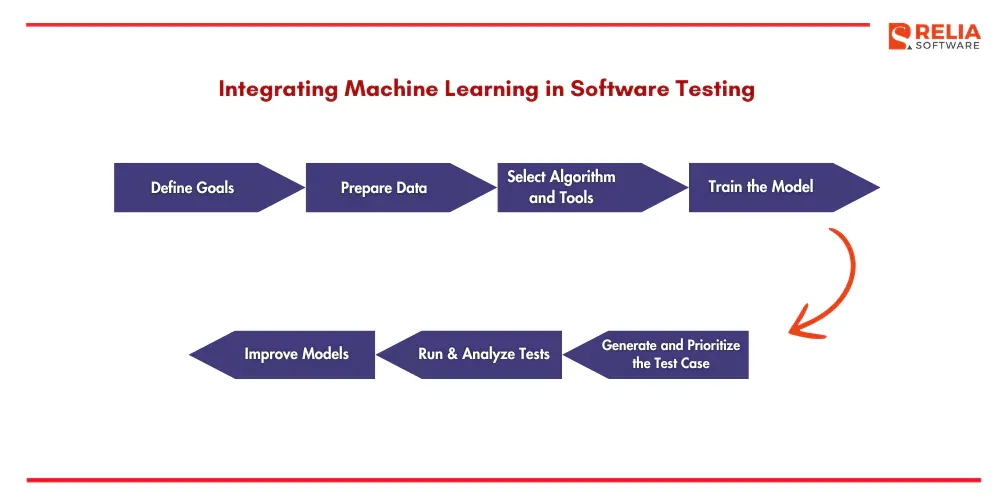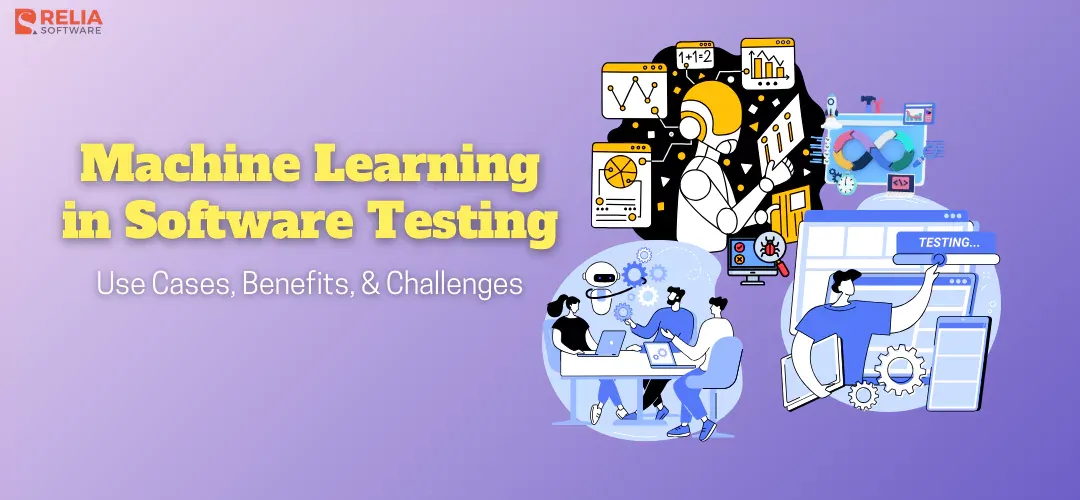Machine learning (ML) automates complex tasks accurately, transforming industries—including software testing. ML makes software testing more adaptive, predictive, and efficient. This blog will explore how machine learning changes testing methods to help teams keep up with fast development cycles.
>> Read more: AI in Software Testing: How It Works, Benefits & Challenges
How Can Machine Learning Be Used in Software Testing?
Machine learning is a valuable tool in software testing due to its work to automate processes, identify problems in advance, and adjust tests according to programs' evolution. It makes software testing more effective, efficient, and flexible. Here is how machine learning works in software testing:
Defect Prediction
By analyzing prior defect data, machine learning algorithms can detect areas of code with more problems. Early detection of high-risk locations allows teams to test the most essential sections and correct issues before they worsen.
Automated Test Case Generation
ML can use data on how people interact to create test cases. This represents real people's behavior, including unexpected situations. For example, in a finance app, ML could rank test cases for high-stakes operations like fund transfers or multi-factor authentication based on real user flows.
Self-Healing Automation Scripts
Apps with frequent UI or code changes can disrupt existing test scripts. Machine learning-driven self-healing scripts can automatically move or rename UI elements. This functionality simplifies test script maintenance and ensures continuous testing.
Anomaly Detection
ML models may discover outliers in large datasets that may indicate hidden issues. This is useful for IoT and real-time analytics systems that handle several transactions or data flows.
Test Case Prioritization
ML algorithms can prioritize test cases based on historical mistakes, user impact, and code readability. For instance, it can also prioritize checkout and payment testing in e-commerce apps.
Targeted Regression Testing
ML might suggest regression tests only for affected sections in response to code changes. Thus, the test suite doesn't need to be repeated after changes. For complex apps, machine learning can determine that a login function modification only impacts particular components farther down the line.
Automated Defect Classification and Solution Linking
ML models may automatically classify defects by severity, kind, or effect and link them to comparable historical issues, helping testers address issues faster. For example, ML can connect 2 issue cases if a new user login module bug resembles a fixed bug to gain important information that speeds up debugging. This speeds up problem resolution so developers can apply repeatable solutions.
Visual Regression Testing
ML-based machine vision techniques can detect slight variations across different screen sizes and resolutions in UI-heavy app screenshots. As an example, ML can detect button placement, color variances, and device alignment issues. This standardizes the user experience and reduces visual checks.
Synthetic Data Generation
Machine learning may create synthetic datasets that simulate unusual or severe conditions that are hard to duplicate. ML can produce data that resembles unique disease symptoms or unexpected treatment combinations in healthcare applications, allowing testers to examine how the system handles these scenarios.
Predictive Test Coverage
ML may constantly monitor test coverage to identify regions that haven't been tested or may have issues. In a complex SaaS platform, ML may find that some API transactions aren't tested enough, requiring tailored testing. ML-driven test coverage analysis finds gaps to solve and ensures balanced and thorough testing, making the product more stable and trustworthy.
>> Read more: Top 9 Machine Learning Platforms for Developers in 2024

Benefits of Using Machine Learning in Software Testing
- Faster Testing: Machine learning tools can automate repetitive tasks and run many test cases simultaneously, speeding up testing. This lets teams release updates quicker and keep up in fast-paced markets.
- Better Accuracy: ML algorithms can spot patterns and hidden flaws that manual testing might miss. This helps catch bugs early, reducing the need for fixes after release.
- Predictive Insights: ML can predict new issues by analyzing past test results. This helps teams prioritize high-risk areas and prevent problems before they happen.
- Improved Test Coverage: Machine learning can process large data sets, covering more areas of the software. This ensures that all software parts are tested, reducing gaps and missing bugs.
- Adaptive Testing: Testing processes can automatically adjust to software changes. Machine learning updates tests to stay relevant as features change or are added, making the process efficient and accurate.
- Reduced Costs: Teams save time and effort by testing faster and more efficiently with fewer repetitive and manual processes. Additionally, early detection reduces costly fixes later, cutting overall testing costs.
Challenges and Solutions in ML-Driven Software Testing
High Setup Costs and Complexity
Establishing machine learning in software testing is costly and complex. New machine-learning teams may need time to train models and link tools.
Solution: Start with simple tasks like automating repetitive tests or prioritizing test cases. Use free or open-source machine learning tools to save money. This aids team learning. As the team improves ML, try more complex models.
Data Quality and Quantity Needs
Machine learning performs best with a large volume of high-quality data. Predictions may be wrong if there isn't enough good data, significantly affecting the test's final results.
Solution: Get good data from past tests and user feedback. Use the company info you already have and create more if necessary. Keep data up to date so that ML models are always correct.
Keeping ML Models Up-to-Date
Software updates may make ML models less effective. This could reduce estimation and test accuracy or miss new bugs.
Solution: To keep ML models accurate, monitor and train them daily with new data. Use self-changing models to avoid updating them.
Limited ML Knowledge
Many testing teams lack the ability to set up and run ML-driven testing. Failure to utilize ML properly due to ignorance could have fatal consequences.
Solution: Train colleagues in testing-related ML concepts in workshops. Collaboration with internal or external data professionals yields the greatest results. Using automatic ML tools to let non-experts create ML models.
Existing Tool and Workflow Integration
Adding ML models to tools and processes in established testing environments may be difficult.
Solution: Choose adaptable ML solutions that use standard testing methods. Use ML in smaller, less-disturbing areas to ease the adjustment. Slowly integrating teams reduces turmoil and helps them adjust.
Interpreting ML Results
ML models can guess and produce confusing results. ML-driven test findings are unclear and unreliable.
Solution: Use decision trees or explanation tools to help teams comprehend model choices in machine learning (ML). Regularly verify ML results to establish trust in ML-driven testing.
Core ML Algorithms and Techniques in Software Testing
>> You may interested: Roadmap To Become A Machine Learning Engineer
Supervised Learning
Supervised learning trains models to predict or classify future data using labeled data. This aids in defect detection and test case prioritization. By learning from past defect data, supervised algorithms identify high-risk code sections, enabling QA teams focus on them.
Unsupervised Learning
Unsupervised learning detects patterns and unexpected behaviors in test results using unlabelled data. Finding outliers and grouping comparable data are common uses. Grouping related test cases can discover hidden issues and remove redundancy, improving test coverage.
Reinforcement Learning
ML models learn from feedback and make decisions via reinforcement learning. This algorithm is ideal for performance optimization and automated testing. As software evolves, reinforcement models can create new test cases and identify the ideal stress and load testing parameters by exploring multiple setups.
Deep Learning
Deep learning analyzes and processes complex data with multi-layered neural networks for high accuracy with minimal human intervention. Visual testing and natural language processing (NLP) benefit most from it. Deep learning detects visual inconsistencies across devices for UI validation, maintaining UI uniformity.
>> Read more: Top 9 Best Deep Learning Frameworks for Developers

How To Integrate Machine Learning in Software Testing?
>> Read more: A Comprehensive Guide to Software Testing Life Cycle (STLC)
Step 1: Define Goals
Start by setting clear objectives for machine learning in testing, such as defect prediction, test case prioritization, auto-generation of test scenarios, etc. You should pay attention to those aspects that can save effort and resources.
Step 2: Prepare Data
- Collect past test information, test cases, results, modifications of code, and the bug report.
- Clean and preprocess the final data to remove incoherencies, errors, and noise.
- Select useful attributes in the data to help the training process when constructing the ML model.
- Split the data set into different sets of train and test data.
Step 3: Select Algorithm and Tools
- Pick ML models that meet your needs. (e.g., classification models can forecast defects, clustering techniques can group related test cases, and NLP can analyze bug reports.)
- TensorFlow, PyTorch, and Applitools let you effortlessly integrate ML into existing testing environments.
>> Read more:
- Top 9 Best DevOps Deployment Tools for Businesses
- Top 22 Best DevOps Automation Tools For Businesses
- Top 9 Machine Learning Platforms for Developers
Step 4: Train the Model
- Feed the training data to the chosen algorithm to train the model.
- Evaluate the model's performance using accuracy, precision, recall, and F1-score metrics.
Step 5: Generate and Prioritize the Test Case
- Use ML algorithms to automatically generate new test cases based on code changes, requirements, and historical data.
- Prioritize test cases based on their risk, impact, and likelihood of failure.
- Reduce the number of test cases while maintaining test coverage.
Step 6: Run and Analyze Tests
- Integrate the ML-powered test cases into automated testing frameworks.
- Use ML algorithms to analyze test results, identify trends, and predict potential failures.
- Set up self-healing mechanisms to automatically fix failing tests.
Step 7: Improve Models
- Continuously feed new data into the ML model to improve its accuracy and performance.
- Periodically retrain the model to adapt to software and testing environment changes.
- Track the model's performance and adjust it as needed.

Comparing Machine Learning with Other Testing Approaches
|
Aspect |
Machine Learning in Software Testing |
Automated Testing |
Manual Testing |
|
Core Function |
Predicts defects Prioritizes tests Adapts to code changes dynamically |
Executes predefined scripts for repetitive tasks |
Relies on human-driven, exploratory testing |
|
Adaptability |
High – learn from data and adapt to ongoing changes |
Moderate - require manual updates |
Low - manually adjust for each change |
|
Execution Speed |
Very High – processes quickly across multiple scenarios |
High – runs faster than manual testing |
Low – slower due to manual effort |
|
Test Case Generation |
Automatically by learning patterns |
Scripted test cases are written manually |
Created manually |
|
Test Maintenance |
Low – Adjust to minor changes automatically |
Moderate – Regular updates to remain effective |
High – requires constant updates |
|
Error Detection Ability |
Automatically detects and improves over time |
Limited, misses unexpected issues |
Depends on tester's ability |
|
Predictive Analysis |
Well-predictive ability before occurring |
Limited to pre-defined scenarios |
Lacks predictive capability, reactive only |
|
Skill Requirement |
High - ML and data handling expertise |
Moderate - scripting and automation tools |
Low - general testing knowledge and expertise |
|
Cost |
High - costs in setup phase, but reduces over time |
Moderate - saves on repetitive tasks but requires script maintenance |
High - due to manual labor |
|
Best For |
Data-driven projects needing adaptability and predictive insights |
Routine testing scenarios with known conditions |
Small projects or detailed exploratory testing |
>> Read more:
- 4 Levels Of Testing In Software Testing
- Detailed Explanation of 7 Software Testing Principles
- Exploring The Importance of Software Testing: 5 Key Benefits
- Manual Testing vs Automation Testing: Which is Better?
- What is Security Testing in Software Testing?
Conclusion
With software applications' growing complexity, machine learning in software testing provides an innovative way to meet these demands. Embracing machine learning enables development teams to streamline testing cycles, improve product quality, and shorten time to market. For organizations aiming to stay competitive with high-quality products, adopting machine learning in testing is no longer just beneficial but essential.
>>> Follow and Contact Relia Software for more information!
- development

